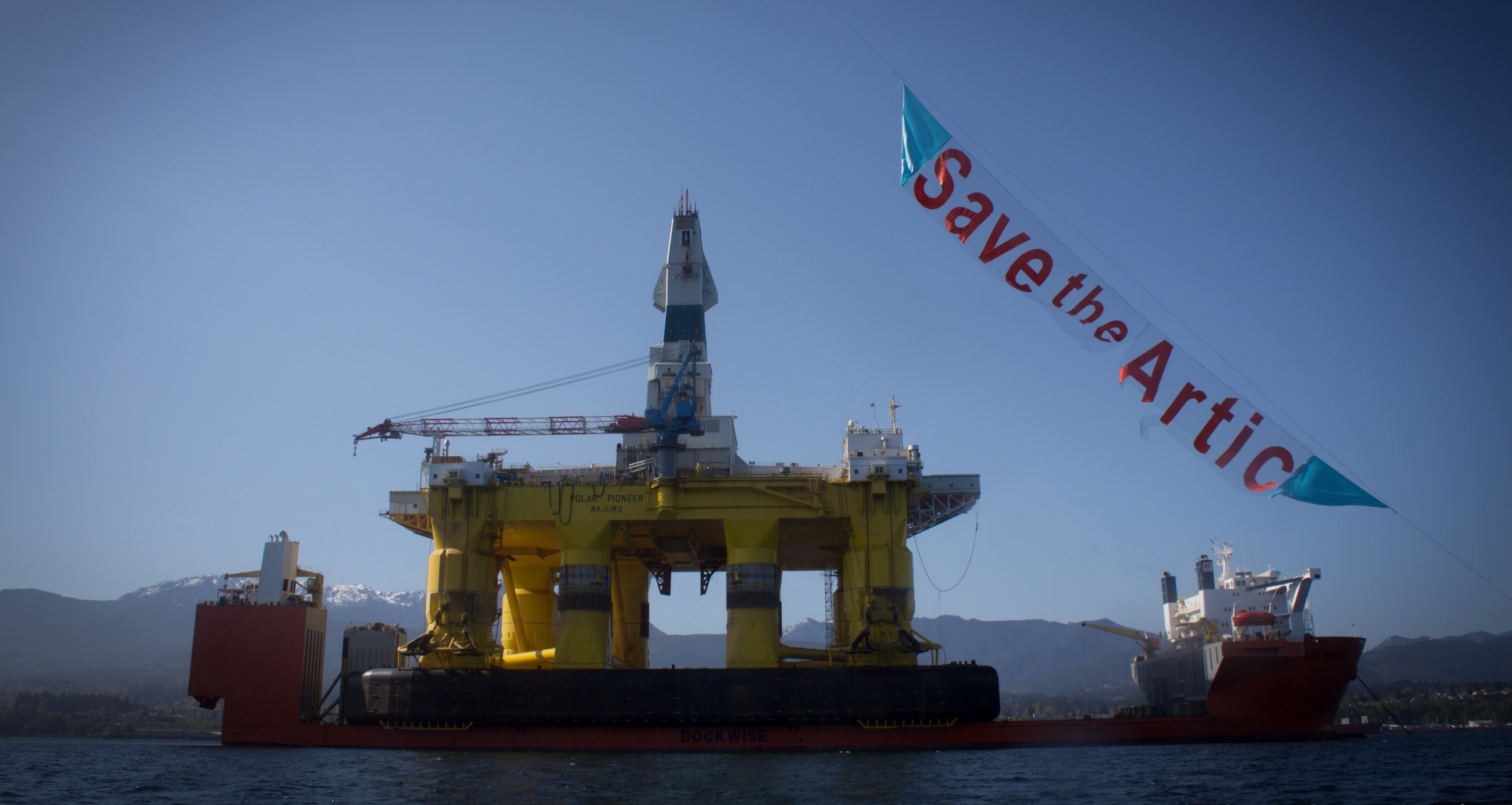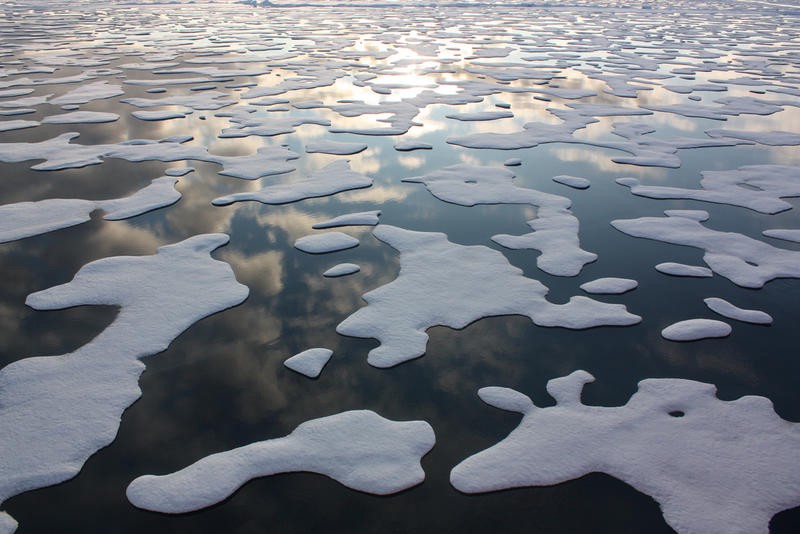

For many years, oil companies and the U.S. government have been trying to open up the Alaskan Arctic region for offshore oil drilling. For an equally long period of time, environmental groups and indigenous communities that fully appreciate the impact of industrial fossil fuel extraction have resisted the sale of leases for the Chukchi and Beaufort Seas to oil giants–this all before governments and the mainstream media took notice.
These long-standing efforts against extractivism, along with endeavors to prevent global temperatures from rising more than two degrees, were recently struck a major blow. Last month, the Obama administration granted approval to oil company Royal Dutch Shell to begin offshore drilling this summer in the Chukchi Sea.
Subhankar Banerjee, a prominent environmental activist and editor of the book Arctic Voices: Resistance at the Tipping Point, knows how disastrous this is for the indigenous communities. In 2001, Banerjee, originally a physicist, left a job at Boeing to live among the indigenous communities of the Alaskan Arctic. Dismayed by industrial exploitation on a warming planet, Banerjee was instinctively drawn to (possibly) the most urgent victims of climate change: the tribal Iñupiat and Gwich’in peoples–communities that have, unbeknownst to the world, been at the frontlines of cataclysmic global warming for years.
The last few decades in the Arctic have witnessed drastically accelerated losses in sea ice and the melting of terrestrial permafrost that has triggered the escape of record-high levels of methane into the East Siberian Arctic Shelf. These changes were accompanied by a precipitous decline in biodiversity within dwindling local populations of caribou, muskoxen, and polar bears.
“When I first went in 2001,” recalled Banerjee, “there was hardly any talk about climate change within the community. The discussion was about the decision to drill for oil in the Arctic. When I returned in 2006, literally within a few years, things had accelerated so fast that everybody was talking about it.”
Particularly for those living within the coastal regions, global warming no longer meant abstract changes in temperature averages in a database, but an immediate threat to survival. As freak weather in the tundra began to turn up dead caribou, it fundamentally altered the subsistence food practices of the Iñupiat community. As the migration patterns of the endangered bowhead whale changed, this threatened traditional whaling practices. Today, with rapid increases in coastal erosion and flooding, 31 indigenous villages are facing impending relocation.
As Banerjee explained, the rapid changes were a shock. “For [the communities], they considered climate change to be what literary studies scholar Rob Nixon calls ‘slow violence.’ But “¦ it’s no longer slow anymore. The Arctic is warming at least twice [as fast as] the global average rate, and these indigenous communities are bearing the brunt of global climate change.”
Although researchers have long been aware of the retreat of Arctic sea ice, the first in-depth reports of a rapidly accelerating loss only emerged in 2007. A report by the Intergovernmental Panel on Climate Change (IPCC) describes a steadily increasing trend in CO2 emissions over the last few decades that was primarily responsible for melting the perennial ice, a rise in sea levels, and losses from land-based ice sheets. The Arctic ice melt in the summer of 2012 broke all previous records.
Meanwhile, big oil companies continued to lobby the U.S. government and buy permits to extract mineral resources from the Arctic. With the zealous support of the Bush administration, the region was opened to leasing in 2003. In 2007, the Interior Department gave Shell a license to carry out exploratory drilling. Drilling ships, barges, steel piers, airboats, and helicopters descended in droves on the continental shelf and the Beaufort Sea. While several environmental groups successfully pursued legal action to suspend drilling, they weren’t fast enough to prevent lasting damage to the inhabitants of neighboring villages.

The menace that offshore drilling in the Arctic poses to Iñupiat lives, livelihoods, and culture was immensely under-reported, even as photographs of stranded polar bears adrift on islands of sea ice went viral. In 2011, Rosemary Ahtuangaruak, an Iñupiat activist and Tribal Liaison for the Alaska Wilderness League, testified to the U.S. House’s Energy and Commerce Committee about a bill allowing oil companies to sidestep Clean Air Act regulations: “If you allow this bill to move forward, you are telling me and everyone who lives in the Arctic that we–proud Iñupiats and Americans–are less important than a few foreign-owned oil companies like Shell.”
Ahtuangaruak, who used to live in a village close to the Prudhoe Bay oil fields, describes how seismic vibrators searching for oil disturbed caribou herds, water sources were found contaminated, natural gas flares caused spikes in respiratory illnesses, and, most touchingly, how the stress and uncertainty of livelihoods caused increases in drug abuse, domestic violence, and suicides in Iñupiat villages.
Once the drilling begins this summer, the threat of catastrophic oil spills will loom large over the public consciousness, haunted by BP’s Deepwater Horizon spill in the Gulf of Mexico and the nine-mile slick currently stretching over the California coast. Five years after the BP spill, dead dolphins and other dead marine animals are still washing ashore in record numbers.
Banerjee argues that in the harsh climate of the Arctic, an oil spill would likely be worse than BP’s disaster. Any spill would get covered over with ice in the winter and could only be dealt with when the ice melted the subsequent summer. Even a small spill would likely spread, due to frequent storms and blizzards, and the nearest Coast Guard station is over a thousand miles away.
All this when a 2014 Department of Interior report acknowledged that there is a 75 percent chance of one or more spills if drilling takes place. If one happens, the threat to the region’s inhabitants will be incalculable.

As a dark cloud hangs over the communities bearing the brunt of a crisis not of their own making, it is worthwhile to ask: What sources of renewable energy could be utilized in the Arctic?
“This is not just a thought experiment,” said Banerjee. “It has already happened, but has not gained momentum. In 2002, in Arctic Village the Gwich’in community installed solar panels above the local washeteria. The idea was to solarize the villages. But, of course, because of the lack of money and impoverishment of the villages, this did not happen.”
Banerjee describes how in 2003, Robert Thompson, an Iñupiat-Athabaskan activist and the chairman of Resisting Environmental Destruction on Indigenous Lands (REDOIL), installed a 30-foot high, 200-watt wind turbine outside the city of Kaktovik. In an interview, Thompson explained how it works: “It’s currently connected to a battery bank for powering tools, appliances, and a computer. I’d like to fix it up to power a small building that people could stay in when they’re working “¦ I know a few people in Kaktovik that are now considering installing their own.”
In a region where strong gusts of cold wind are incessant, REDOIL is currently proposing innovative ways to supply wind energy along the Arctic coast. Said Banerjee: “The pilot project is ongoing, but it is extremely clear that a small amount of investment could make all villages wind-dependent.”
A recently published report by Victoria Hermann, a Ph.D. student at the University of Cambridge, for the independent think tank The Arctic Institute argues for just that: investment in the Arctic to build the physical infrastructure for sustainable living. Hermann writes that this will be the cornerstone of change from an extractive, resource-driven economic climate to green practices like the installation of solar panels and wind turbines.
There is no shortage of evidence that local, creative solutions work. While the North American Arctic economy still relies heavily on extractive fossil fuel industries, homegrown solutions have been emerging from the Nordic Arctic regions for years. In Sisimiut Greenland, for instance, the Center for Arctic Technology trains engineers; employs research teams to investigate green, sustainable solutions; and conducts pilot studies. The center is at the forefront of some of the most innovative green solutions, such as low-energy housing and solar heating in schools.
A revitalization of the economy and culture of the Alaskan Arctic is well within our grasp–provided bodies like the U.S. government listen to indigenous innovators. They are, after all, people who have spent much of their lives facing global warming and climactic extremes in a way most of us cannot fathom.


How We Get To Next was a magazine that explored the future of science, technology, and culture from 2014 to 2019. This article is part of our Nature & Climate section, which looks at how human activity is changing the planet–for better or worse. Click the logo to read more.
